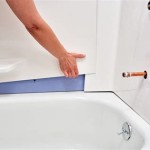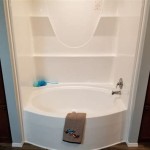Essential Aspects of Minimum Bathroom Size for Bathtub
Designing a bathroom that accommodates a bathtub can be challenging, especially in smaller spaces. However, with careful planning and consideration of essential aspects, it's possible to create a funcional and comfortable bathroom that includes this luxurious feature.
Tub Dimensions
The key factor to consider when determining the minimum bathroom size for a bathtub is the tub's dimensions. Standard bathtubs typically measure around 60 inches long, 30 inches wide, and 14 inches deep. However, these dimensions can vary depending on the specific model and style of the tub.
Circulation Space
In addition to the tub's dimensions, it's essential to allow for sufficient circulation space around the bathtub. This space is necessary for entering and exiting the tub, as well as for reaching nearby fixtures and amenities. The International Residential Code (IRC) recommends a minimum of 30 inches of clearance on all sides of the bathtub.
Tub Orientation and Placement
The orientation and placement of the bathtub can significantly impact the overall space requirements. Freestanding tubs, which are not attached to walls, require more circulation space on all sides. Alcove tubs, which are installed in a recessed area between walls, can save space but may limit accessibility.
Bathroom Shape and Layout
The shape and layout of the bathroom also play a role in determining the minimum size. A square or rectangular bathroom with ample wall space can accommodate a bathtub more easily than a narrow or L-shaped bathroom. Proper positioning of the tub can optimize space utilization and create a balanced and functional layout.
Additional Considerations
Besides the essential aspects mentioned above, there are a few additional considerations to keep in mind when determining the minimum bathroom size for a bathtub:
- Door Swing: Ensure that the bathroom door swings in or out without obstructing access to the bathtub.
- Shower Curtain or Enclosure: If a shower curtain or enclosure is used, add an additional 12-18 inches of space for clearance.
- Storage: Consider incorporating storage solutions such as shelves or drawers nearby for towels, toiletries, and other bath essentials.
- Ventilation: Proper ventilation is crucial to prevent moisture buildup and mildew. Include exhaust fans or windows to maintain adequate airflow.
By carefully considering these essential aspects, it's possible to design a bathroom with a bathtub that meets both functional and aesthetic needs, even in smaller spaces.

Bathroom Measurement Guide These Are The Measurements You Need To Know

The Most Common Bathroom Sizes And Dimensions In 2025 Badeloft

What Size Is A Small Bath Ideal Baths For Bathrooms

Bathtub Sizes Standard Largest And Smallest By Type Modernize

Bathroom Dimensions Useful Wc

Bathrooms And Layouts Residential Bathroom Design

Bathroom Dimensions For Toilets Sinks Showers And Bathtubs Doorways

Ada Compliance Bathtubs

Standard Bath Size Length Width Dimensions

Standard Bathroom Size For Efficiency And Comfort








